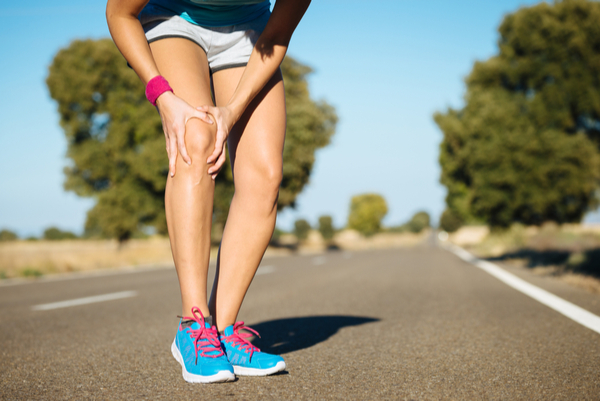
The knee is the largest joint of the body. It is made up of the femur (the thigh bone, and the longest bone in the body!), the tibia (the shin bone), and the patella (the knee cap). Also, closely related to the knee is the fibula (on the outer side of the lower leg). Resting between the femur and tibia are two menisci, which provide cushion and shock absorption between the bones. The bones are held in place by ligaments: the anterior and posterior cruciate ligaments, and medial and lateral collateral ligaments. There are also several bursae (fluid-filled sacs) that provide cushion and help reduce friction between bones and other structures.
The knee is a “hinge-joint” and moves primarily into flexion and extension (bending and straightening) between the ends of the femur and the tibia. There is also a small amount of rotation and gliding that occurs between the tibia and femur to allow for full flexion and extension motion. The patella sits in a groove in the front of the femur, and glides up and down in the groove with knee flexion and extension. The quadriceps muscle group on the front of the thigh is the main muscle that does knee extension, and the hamstrings muscle group on the back of the thigh is the main muscle that does knee flexion. The knee is also greatly influenced by the hip and foot movement.
Common injuries to the knee include osteoarthritis, patellofemoral pain, tendinitis, ligament sprain, overuse injury, and meniscus tear. Osteoarthritis is often due to normal “wear and tear” of the joint surface, and often occurs with aging. It can also have underlying causes such as weakness of the hip and lower extremity, trauma, poor movement patterns, and overuse. Patellofemoral pain is often due to weakness of the hip and lower extremity, trauma, poor movement patterns, and overuse. It is most common in adolescent girls who are very active in sports that involve running and jumping (soccer, volleyball, basketball, etc.) Tendinitis is caused by overuse, or an abrupt increase in activity such as running. Ligament sprains and meniscus tears are most common in active individuals, or related to a trauma such as a fall or accident. For the active person, these injuries can be related to running, cutting, jumping or twisting injuries. They can be caused by direct contact, or due to weakness or poor stability of the hip and lower extremity. Other overuse injuries are IT band syndrome
Depending on the type and severity of the injury, many times it can be treated conservatively, without surgical intervention, with Physical Therapy. Treatment is focused around reducing pain and inflammation, improving mobility, increasing strength, and improving functional activity. We use a variety of techniques and treatment methods in Physical Therapy to help our patients in recovering from knee injuries. These include hands-on treatments, guided stretching and strength training, neuromuscular re-education, gait training, balance training, functional and return to sport training, and therapeutic modalities.
If you have questions about PT or your knee pain, give us a call for a FREE consultation with one of our highly trained Doctors of Physical Therapy. You will have a chance to find out more about what we do, and how we can help you get back to doing the things you love as quickly as possible.


